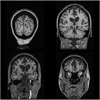Symmetric corticobasal degeneration (S-CBD)
- PMID: 20018548
- PMCID: PMC2941264
- DOI: 10.1016/j.parkreldis.2009.11.013
Symmetric corticobasal degeneration (S-CBD)
Abstract
Background: Corticobasal degeneration (CBD) is a neurodegenerative disease characterized pathologically by neuronal loss, gliosis and tau deposition in neocortex, basal ganglia and brainstem. Typical clinical presentation is known as corticobasal syndrome (CBS) and involves the core features of progressive asymmetric rigidity and apraxia, accompanied by other signs of cortical and extrapyramidal dysfunction. Asymmetry is also emphasized on neuroimaging.
Objective: To describe a series of cases of CBD with symmetric clinical features and to compare clinical and imaging features of these symmetric CBD cases (S-CBD) to typical cases of CBS with CBD pathology.
Methods: All cases of pathologically confirmed CBD from the Mayo Clinic Rochester database were identified. Clinical records were reviewed and quantitative volumetric analysis of symmetric atrophy on head MRI using atlas based parcellation was performed. Subjects were classified as S-CBD if no differences had been observed between right- and left-sided cortical or extrapyramidal signs or symptoms. S-CBD cases were compared to 10 randomly selected typical CBS cases.
Results: Five cases (2 female) met criteria for S-CBD. None had limb dystonia, myoclonus, apraxia or alien limb phenomena. S-CBD cases had significantly less asymmetric atrophy when compared with CBS cases (p=0.009); they were also younger at onset (median 61 versus 66 years, p<0.05) and death (67 versus 73 years, p<0.05). Family history was present in 40% of S-CBD cases.
Conclusions: CBD can have a symmetric presentation, clinically and radiologically, in which typical features of CBS, such as limb apraxia, myoclonus, dystonia and alien limb phenomenon, may be absent.
Copyright (c) 2009 Elsevier Ltd. All rights reserved.
Figures




References
-
- Dickson DW, Bergeron C, Chin SS, Duyckaerts C, Houropian D, Ikeda K, et al. Office of Rare Diseases neuropathologic criteria for corticobasal degeneration. J Neuropathol Exp Neurol. 2002;61:935–946. - PubMed
-
- Rebeiz JJ, Kolodny EH, Richardson EP. Corticodentatonigral Degeneration with Neuronal Achromasia. Arch Neurol. 1968;18:20–33. - PubMed
-
- Boeve BF, Lang AE, Litvan I. Corticobasal degeneration and its relationship to progressive supranuclear palsy and frontotemporal dementia. Ann Neurol. 54:S15–S19. 200. - PubMed
-
- Pillon B, Blin J, Viadailet M, Deweer B, Sirigu A, Dubois B, Agid Y. The neuropsychological pattern of corticobasal degeneration. Neurol. 1995;45:1477–1483. - PubMed
-
- Massman PJ, Kreiter KT, Jankovic J, Doody RS. Neuropsychological functioning in cortico-basal ganglionic degeneration: Differentiation from Alzheimer’s disease. Neurol. 1996;46:20–726. - PubMed
Publication types
MeSH terms
Grants and funding
LinkOut - more resources
Full Text Sources
Medical
Miscellaneous

